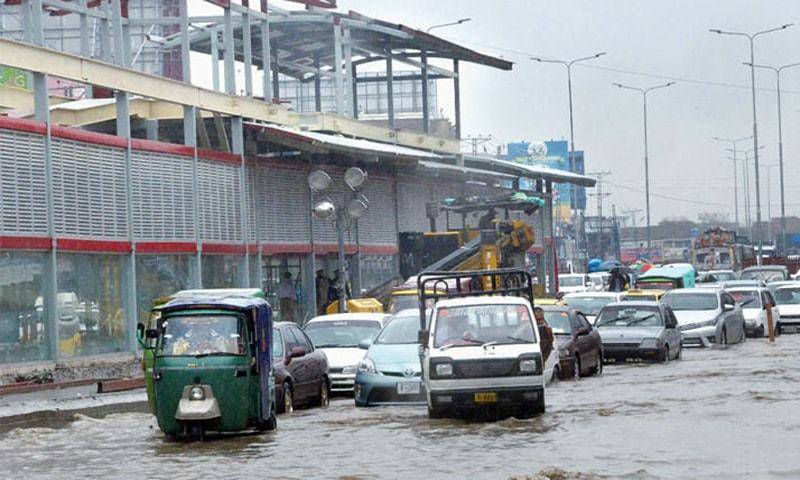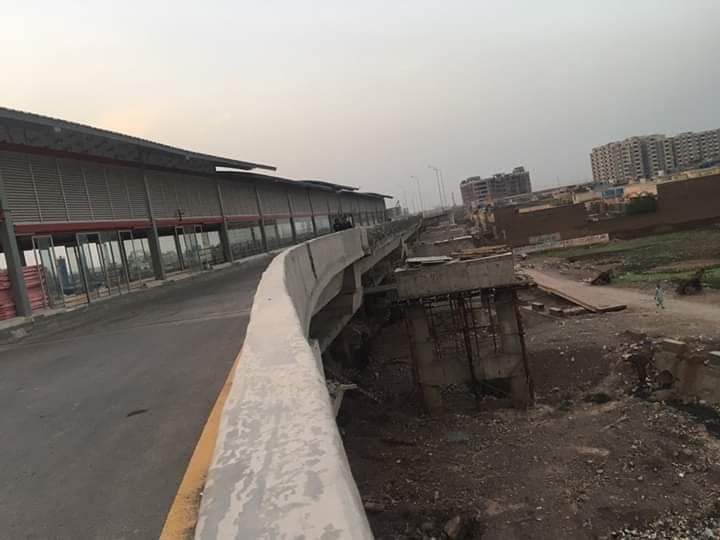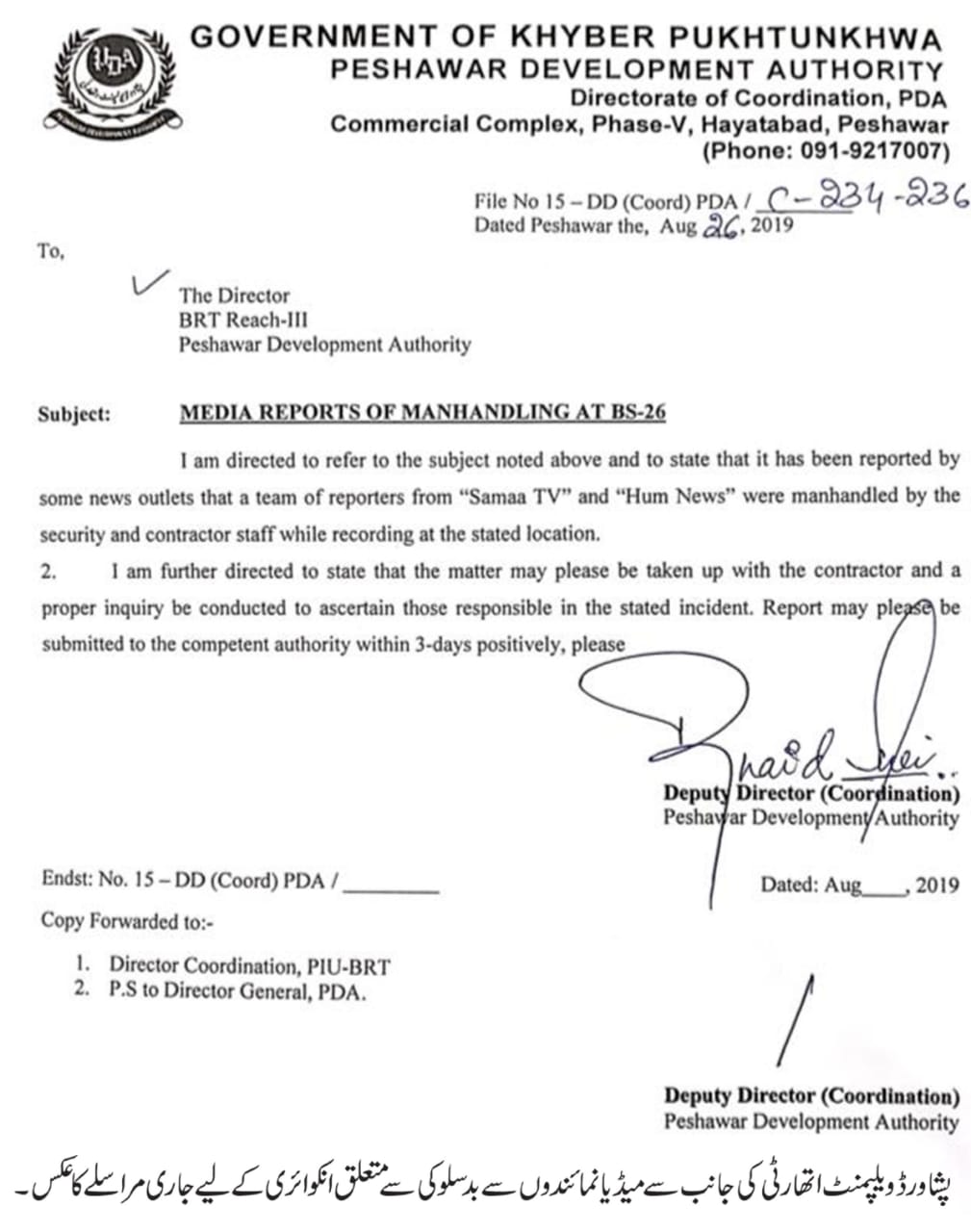
PESHAWAR: The PTI government is facing severe criticism for not completing the Bus Rapid Transit (BRT) Peshawar project which is marred by design flaws, poor quality of work and cost escalation.
The biggest flaw in the BRT project, noticed and discussed by the masses, is that the work was initiated soon after the provincial government spent billions on the Clean and green Peshawar Project. Therefore, the Peshawar Development Authority (PDA) destroyed initiatives taken under the green and clean project for the construction of BRT corridor.
The provincial government representatives say that the BRT project has become the biggest challenge for both federal and provincial governments due its losing credibility and charm.
As flaws of serious nature in design and execution of project increased the worries of officials, it has more become a matter of frustration for the provincial government rather than excitement.
There is a long list of flaws and one of these is only one emergency exit point contrary to what is offered in the similar projects of Punjab where there are three to four points.
The poor designing and execution is most visible at the entrance of several bus stations – 10, 12, 15 and 20 – which is narrower than the buses. For example, the station constructed at Tehkal was razed to the ground because the buses could not pass through it. It clearly shows that no proper homework was done before launching the project.

There is another issue too: the curves/turns in the elevated corridor are so narrow that the drivers would have to slow buses at these points. Hence, extra pillars were added to the structure in the Saddar area to widen the curve.
These are just a few examples of not only poor designing and execution but also cost escalation which is already the biggest issue for the government.
And talking about cost escalation and poor planning, the BRT engineers failed to design and construct a station in the Hayatabad area. So what did they do? They erased a portion of the already constructed corridor to add the station.

Due to the frequent changes in shape and design, it is now a routine to watch labourers tearing apart the constructed structures for reconstruction.
Amid all the chaos, it is a no surprise that the project is a huge attraction for the social media users albeit for all the wrong reasons.
One of the episodes was an underpass at Aman Chowk where the engineers failed to notice a gas pipeline crossing right through the middle of it. It was only after an image went viral on social media that the PDA shifted the pipeline.
Same was the public reaction after a picture emerged in which a barber could be seen at his “shop” on a track made for people to reach the station.
Meanwhile, the iron bars used to separate the corridor from road were also stolen, enabling the people to cross bus track on foot.
Naturally, this entire episode has serious repercussions for general public who are facing a plethora of problems due to the project which is supposed to make their life easier.
During the construction work, the gas and water pipelines were badly damaged throughout the city due to which people suffered a lot as the government failed to provide any alternative.
As the construction of a project is incomplete even after two years, it has the traders along the GT Road and the University Road are facing huge losses as customers are avoiding the areas located around the corridor.
On GT Road, many shops were removed for the project and the business community is still struggling to get compensation. It is estimated that the businesses along the GT Road have lost 40 per cent trade.
On the other hand, the corridor construction has generated a serious drainage problem in the city, as the two main arteries – GT Road and University Road – are turned into canals after even light rain. The reason: broken existing drainage lines and not paying attention to new system during and after the construction.
In fact, the corridor doesn’t have any plan or system to stop rainwater gushing through the underpasses.
Meanwhile, the boundary wall of famous Jinnah Park, located opposite to the Qila Bala Hisar and which is considered a political heritage, has also been damaged during construction.
Experts say that the BRT project cost increased due to repeated changes in design and the resources wasted on reconstruction.
The Asian Development Bank, which funded the project, also issued a report in which corruption and kickbacks were mentioned.
Soon after the ADB report, Chief Minister Mehmood khan directed an inquiry into the matter. Earlier, he had said the project would be inaugurated within a year of the current government, but the PTI once again failed to launch the BRT according to the promise.
Meanwhile, the PDA has decided to launch an inquiry into the manhandling of media persons by the security and contract staff.

The incident happened as these media persons tried to cover the construction and the changes being made in the project.
The biggest flaw in the BRT project, noticed and discussed by the masses, is that the work was initiated soon after the provincial government spent billions on the Clean and green Peshawar Project. Therefore, the Peshawar Development Authority (PDA) destroyed initiatives taken under the green and clean project for the construction of BRT corridor.
The provincial government representatives say that the BRT project has become the biggest challenge for both federal and provincial governments due its losing credibility and charm.
As flaws of serious nature in design and execution of project increased the worries of officials, it has more become a matter of frustration for the provincial government rather than excitement.
There is a long list of flaws and one of these is only one emergency exit point contrary to what is offered in the similar projects of Punjab where there are three to four points.
The poor designing and execution is most visible at the entrance of several bus stations – 10, 12, 15 and 20 – which is narrower than the buses. For example, the station constructed at Tehkal was razed to the ground because the buses could not pass through it. It clearly shows that no proper homework was done before launching the project.

There is another issue too: the curves/turns in the elevated corridor are so narrow that the drivers would have to slow buses at these points. Hence, extra pillars were added to the structure in the Saddar area to widen the curve.
These are just a few examples of not only poor designing and execution but also cost escalation which is already the biggest issue for the government.
And talking about cost escalation and poor planning, the BRT engineers failed to design and construct a station in the Hayatabad area. So what did they do? They erased a portion of the already constructed corridor to add the station.

Due to the frequent changes in shape and design, it is now a routine to watch labourers tearing apart the constructed structures for reconstruction.
Amid all the chaos, it is a no surprise that the project is a huge attraction for the social media users albeit for all the wrong reasons.
One of the episodes was an underpass at Aman Chowk where the engineers failed to notice a gas pipeline crossing right through the middle of it. It was only after an image went viral on social media that the PDA shifted the pipeline.
Same was the public reaction after a picture emerged in which a barber could be seen at his “shop” on a track made for people to reach the station.
Meanwhile, the iron bars used to separate the corridor from road were also stolen, enabling the people to cross bus track on foot.
Naturally, this entire episode has serious repercussions for general public who are facing a plethora of problems due to the project which is supposed to make their life easier.
During the construction work, the gas and water pipelines were badly damaged throughout the city due to which people suffered a lot as the government failed to provide any alternative.
As the construction of a project is incomplete even after two years, it has the traders along the GT Road and the University Road are facing huge losses as customers are avoiding the areas located around the corridor.
On GT Road, many shops were removed for the project and the business community is still struggling to get compensation. It is estimated that the businesses along the GT Road have lost 40 per cent trade.
On the other hand, the corridor construction has generated a serious drainage problem in the city, as the two main arteries – GT Road and University Road – are turned into canals after even light rain. The reason: broken existing drainage lines and not paying attention to new system during and after the construction.
In fact, the corridor doesn’t have any plan or system to stop rainwater gushing through the underpasses.
Meanwhile, the boundary wall of famous Jinnah Park, located opposite to the Qila Bala Hisar and which is considered a political heritage, has also been damaged during construction.
Experts say that the BRT project cost increased due to repeated changes in design and the resources wasted on reconstruction.
The Asian Development Bank, which funded the project, also issued a report in which corruption and kickbacks were mentioned.
Soon after the ADB report, Chief Minister Mehmood khan directed an inquiry into the matter. Earlier, he had said the project would be inaugurated within a year of the current government, but the PTI once again failed to launch the BRT according to the promise.
Meanwhile, the PDA has decided to launch an inquiry into the manhandling of media persons by the security and contract staff.

The incident happened as these media persons tried to cover the construction and the changes being made in the project.
